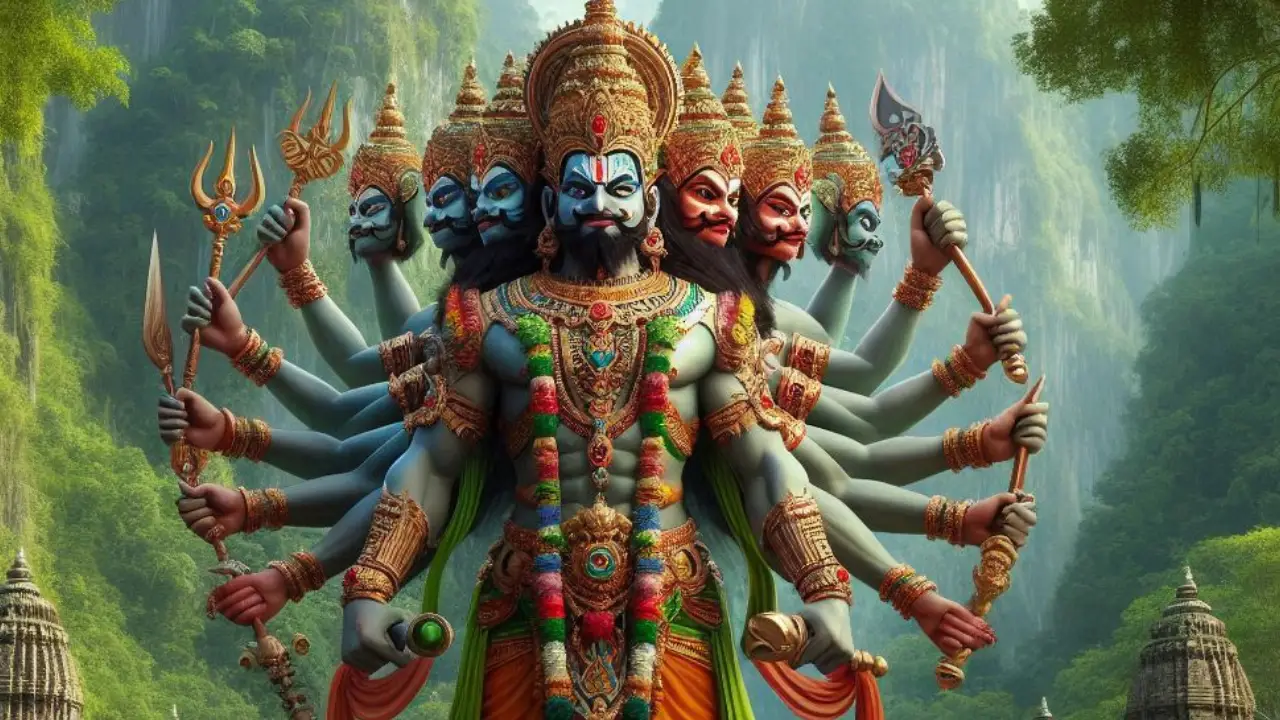Ravana, one of the most fascinating and multifaceted characters in Hindu mythology, continues to captivate minds and stir debates. His story, woven into the epic Ramayana, reveals a figure of immense power, intellect, and ambition, yet one marred by hubris and downfall. This blog delves into the life of Ravana, exploring his origins, his reign as the Demon King of Lanka, and the enduring lessons his tale imparts.
The Birth and Early Life of Ravana
Ravana was born to a sage named Vishrava and a demoness named Kaikesi. This unique parentage endowed him with both the wisdom of the Brahmins and the strength of the Rakshasas (demons). His birth name was Dasamukha, meaning “one with ten faces,” symbolizing his vast knowledge and formidable power. Ravana often interpreted his ten heads as representing his mastery over the four Vedas and six Shastras.
The Rise to Power
From a young age, Ravana exhibited extraordinary abilities and a thirst for knowledge. He performed severe penance to please Lord Brahma, who granted him invincibility against gods and demons, though not against humans or animals. Armed with this boon, Ravana set out to conquer the three worlds, establishing himself as a dominant force.
Ravana’s kingdom, Lanka, flourished under his rule. Described as a city of gold, it was a place of prosperity and advanced civilization. Ravana was a great ruler who ensured the well-being of his subjects. His governance, military strategies, and cultural patronage made Lanka a formidable and respected kingdom.
The Abduction of Sita
The pivotal moment in Ravana’s story is his abduction of Sita, the wife of Lord Rama. This act, driven by desire and vengeance, set the stage for the epic battle between Rama and Ravana. Rama and Lakshmana humiliated Ravana’s sister, Shurpanakha, prompting Ravana to seek retribution. Disguising himself as a sage, Ravana kidnapped Sita and brought her to Lanka, confident in his ability to defeat any challenger.
The War with Rama
Rama, with his brother Lakshmana and an army of monkeys led by Hanuman, launched a campaign to rescue Sita. The ensuing war was a monumental clash of good versus evil. Rama, embodying dharma (righteousness), ultimately defeated Ravana despite his valor and strategic brilliance. Ravana’s death symbolized the triumph of virtue over vice.
Ravana: A Multifaceted Personality
Ravana’s character defies simple categorization. He was not merely a villain but a complex figure with commendable qualities. A devout follower of Lord Shiva, he was a scholar, and a capable ruler. He composed the Shiva Tandava Stotra, a hymn in praise of Shiva, due to his profound devotion.
People often perceive Ravana’s ten heads as a symbol of his arrogance, but they also represent his multifaceted nature. Each head signifies a different aspect of his personality: wisdom, power, intellect, aggression, and more. This duality makes Ravana a compelling character, embodying both admirable and condemnable traits.
Lessons from Ravana’s Story
Ravana’s story offers numerous lessons. His life illustrates the perils of unchecked ambition and desire. Despite his strengths, Ravana’s inability to control his lust and ego led to his downfall. His tale serves as a reminder of the importance of humility, righteousness, and the consequences of deviating from the path of dharma.
Moreover, Ravana’s devotion to Shiva highlights the complexity of morality in Hinduism. It suggests that even those who fall from grace can possess redeeming qualities. This duality encourages a more nuanced understanding of right and wrong, urging us to look beyond black-and-white moral judgments.
Modern Interpretations of Ravana
In contemporary times, Ravana is often reevaluated through various lenses. Some view him as a tragic hero, a capable ruler whose flaws led to his ruin. Others see him as a symbol of resistance and non-conformity. Festivals like Dussehra, which celebrates the victory of Rama over Ravana, also serve as a time to reflect on the values that guide human conduct.
Conclusion
Ravana’s story, rich with complexity and moral lessons, continues to resonate in modern times. He is a reminder of the delicate balance between power and virtue, knowledge and humility. As we delve into the narrative of this Demon King, we find a character who, despite his flaws, remains a significant figure in Hindu mythology.
Ravana’s tale challenges us to look deeper into the duality of human nature and the eternal struggle between good and evil. His life, full of grandeur and tragedy, invites us to reflect on our own choices and the values we uphold.
Feel free to share your thoughts on Ravana. What aspects of his story intrigue you the most? Leave a comment below and join the conversation!

